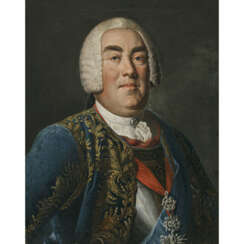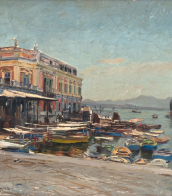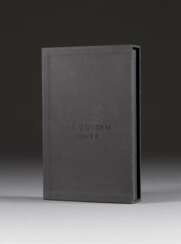rotari

Pietro Antonio Rotari was an Italian painter born in Verona on September 30, 1707. His early artistic development was influenced by his studies under Antonio Balestra and later Francesco Trevisani and Francesco Solimena in Rome and Naples. Rotari's style evolved from history painting to focus primarily on portraitures, particularly of women, which garnered him significant acclaim.
Rotari's career spanned various European cities, with significant periods in Venice, Rome, and eventually Saint Petersburg, Russia, where he was invited by Empress Elizabeth in 1756 to become a court painter. His works are known for their emotional depth and the delicate portrayal of his subjects, often depicted in elegant, idealized manners that emphasized expressions of melancholy, surprise, or joy.
Many of Rotari's most celebrated works are portraits of young women in ethnic or regional costumes, displaying a range of subtle emotions. These works, often referred to as "character heads," are notable examples of his contribution to the rococo style, blending Italian artistry with international elements. His paintings are housed in several prominent collections, including the Cabinet of the Muses at Peterhof in Russia.
For those interested in the works and legacy of Pietro Antonio Rotari, particularly collectors and art historians, staying informed about exhibitions and auctions can enhance appreciation and opportunities to acquire his art. Sign up for updates on new sales and auction events featuring Rotari's works.


Pietro Antonio Rotari was an Italian painter born in Verona on September 30, 1707. His early artistic development was influenced by his studies under Antonio Balestra and later Francesco Trevisani and Francesco Solimena in Rome and Naples. Rotari's style evolved from history painting to focus primarily on portraitures, particularly of women, which garnered him significant acclaim.
Rotari's career spanned various European cities, with significant periods in Venice, Rome, and eventually Saint Petersburg, Russia, where he was invited by Empress Elizabeth in 1756 to become a court painter. His works are known for their emotional depth and the delicate portrayal of his subjects, often depicted in elegant, idealized manners that emphasized expressions of melancholy, surprise, or joy.
Many of Rotari's most celebrated works are portraits of young women in ethnic or regional costumes, displaying a range of subtle emotions. These works, often referred to as "character heads," are notable examples of his contribution to the rococo style, blending Italian artistry with international elements. His paintings are housed in several prominent collections, including the Cabinet of the Muses at Peterhof in Russia.
For those interested in the works and legacy of Pietro Antonio Rotari, particularly collectors and art historians, staying informed about exhibitions and auctions can enhance appreciation and opportunities to acquire his art. Sign up for updates on new sales and auction events featuring Rotari's works.


Pietro Antonio Rotari was an Italian painter born in Verona on September 30, 1707. His early artistic development was influenced by his studies under Antonio Balestra and later Francesco Trevisani and Francesco Solimena in Rome and Naples. Rotari's style evolved from history painting to focus primarily on portraitures, particularly of women, which garnered him significant acclaim.
Rotari's career spanned various European cities, with significant periods in Venice, Rome, and eventually Saint Petersburg, Russia, where he was invited by Empress Elizabeth in 1756 to become a court painter. His works are known for their emotional depth and the delicate portrayal of his subjects, often depicted in elegant, idealized manners that emphasized expressions of melancholy, surprise, or joy.
Many of Rotari's most celebrated works are portraits of young women in ethnic or regional costumes, displaying a range of subtle emotions. These works, often referred to as "character heads," are notable examples of his contribution to the rococo style, blending Italian artistry with international elements. His paintings are housed in several prominent collections, including the Cabinet of the Muses at Peterhof in Russia.
For those interested in the works and legacy of Pietro Antonio Rotari, particularly collectors and art historians, staying informed about exhibitions and auctions can enhance appreciation and opportunities to acquire his art. Sign up for updates on new sales and auction events featuring Rotari's works.


Robert Rotar, actually Holger Skiebe, was a German conceptual artist and photographer.


Alessandro Varotari, commonly known as Il Padovanino, was an influential Italian painter from the late-Mannerist and early-Baroque Venetian school. Born in Padua in 1588, Varotari's artistic journey was deeply influenced by his father, Dario Varotari the Elder, a local painter and architect. His works exhibit a profound influence of Titian, reflecting a faithful adherence to the style and spirit of the Renaissance master throughout his career.
Padovanino's move to Venice in 1614 marked a significant phase in his career, where his narrative ability and sensuality in painting were highly regarded. Notable for his talents as a copyist, Padovanino also earned recognition for his original works, which are characterized by their narrative depth and expressive sensuality. His pupils included renowned artists like Pietro Liberi and Giulio Carpioni, highlighting his role as a mentor in the Venetian art scene.
His paintings, such as "The Incredulity of St. Thomas" and "Virgin and Child," demonstrate his meticulous approach to composition and detail, making significant contributions to the art world that lasted well into the seventeenth century. Varotari's works can be found in various prestigious collections, including the Gallerie dell'Accademia in Venice and the Brera Gallery in Milan, underscoring his lasting legacy in the realm of Italian art.
For art collectors and enthusiasts seeking to delve deeper into the world of Italian Mannerist and Baroque painting, Alessandro Varotari's oeuvre offers a fascinating exploration of narrative, technique, and stylistic evolution. His commitment to capturing the essence of his subjects, coupled with his ability to blend tradition with innovation, ensures his place among the notable figures in art history.
For art collectors and experts interested in Alessandro Varotari's works, this is your opportunity to deepen your appreciation and understanding of his art. By signing up for updates, you'll receive exclusive information about new sales, auctions, and exhibitions related to Varotari's masterpieces. Don't miss the chance to enhance your collection with the works of this distinguished Italian painter. Sign up now and stay informed about the latest opportunities to acquire pieces of Varotari's legacy.


Robert Rotar, actually Holger Skiebe, was a German conceptual artist and photographer.



Pietro Antonio Rotari was an Italian painter born in Verona on September 30, 1707. His early artistic development was influenced by his studies under Antonio Balestra and later Francesco Trevisani and Francesco Solimena in Rome and Naples. Rotari's style evolved from history painting to focus primarily on portraitures, particularly of women, which garnered him significant acclaim.
Rotari's career spanned various European cities, with significant periods in Venice, Rome, and eventually Saint Petersburg, Russia, where he was invited by Empress Elizabeth in 1756 to become a court painter. His works are known for their emotional depth and the delicate portrayal of his subjects, often depicted in elegant, idealized manners that emphasized expressions of melancholy, surprise, or joy.
Many of Rotari's most celebrated works are portraits of young women in ethnic or regional costumes, displaying a range of subtle emotions. These works, often referred to as "character heads," are notable examples of his contribution to the rococo style, blending Italian artistry with international elements. His paintings are housed in several prominent collections, including the Cabinet of the Muses at Peterhof in Russia.
For those interested in the works and legacy of Pietro Antonio Rotari, particularly collectors and art historians, staying informed about exhibitions and auctions can enhance appreciation and opportunities to acquire his art. Sign up for updates on new sales and auction events featuring Rotari's works.


Pietro Antonio Rotari was an Italian painter born in Verona on September 30, 1707. His early artistic development was influenced by his studies under Antonio Balestra and later Francesco Trevisani and Francesco Solimena in Rome and Naples. Rotari's style evolved from history painting to focus primarily on portraitures, particularly of women, which garnered him significant acclaim.
Rotari's career spanned various European cities, with significant periods in Venice, Rome, and eventually Saint Petersburg, Russia, where he was invited by Empress Elizabeth in 1756 to become a court painter. His works are known for their emotional depth and the delicate portrayal of his subjects, often depicted in elegant, idealized manners that emphasized expressions of melancholy, surprise, or joy.
Many of Rotari's most celebrated works are portraits of young women in ethnic or regional costumes, displaying a range of subtle emotions. These works, often referred to as "character heads," are notable examples of his contribution to the rococo style, blending Italian artistry with international elements. His paintings are housed in several prominent collections, including the Cabinet of the Muses at Peterhof in Russia.
For those interested in the works and legacy of Pietro Antonio Rotari, particularly collectors and art historians, staying informed about exhibitions and auctions can enhance appreciation and opportunities to acquire his art. Sign up for updates on new sales and auction events featuring Rotari's works.


Robert Rotar, actually Holger Skiebe, was a German conceptual artist and photographer.


Robert Rotar, actually Holger Skiebe, was a German conceptual artist and photographer.


Robert Rotar, actually Holger Skiebe, was a German conceptual artist and photographer.









































































